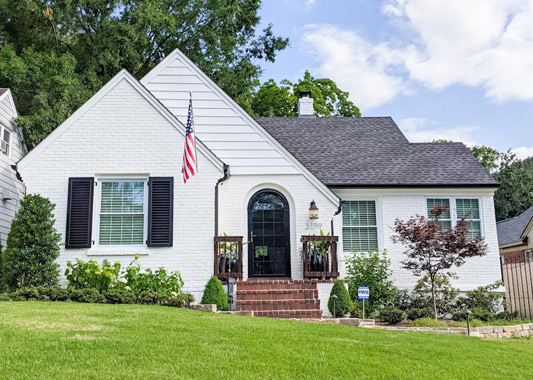Get the Look You Want with Romabio Limewash
Our Classico Limewash is gorgeous on brick or stone, and it looks even better with a little distressing. Distressed limewash gives off a timeless and antique look, creating a nostalgic, and welcoming aesthetic. Classico Limewash is the perfect product to artistically transform your home’s Exterior or Interior brick or stone surfaces.
And the good news is that Romabio Classico Limewash is not hard to distress. In fact, we designed it with authentic slaked lime to make it easy to apply and even easier to distress.
Distressed, lime washed brick is effortlessly achieved with a garden hose on Exterior surfaces and with a water spray bottle on Interior surfaces.
Key Factors that Impact Distressing Limewash:
- The texture and color of your brick or stone
- The absorbency of your surface
- How much water you use
- How much limewash you choose to spray, wash, rub, or scrub off
Distressing limewash is an amazingly easy process, but it requires a little artistry.
How to Distress Limewash: The Basics
After following instructions on how to properly dilute and mix Classico Limewash, lightly dampen your masonry surface and apply the limewash evenly over the area. You do not need to be perfect with your application. That is the beauty of Classico Limewash: imperfections make perfection!
Let it dry for 10 – 90 minutes (depending on absorbency of the surface and air temperature). You can tell when the limewash is drying because unlike ‘paint,’ Classico Limewash gets lighter and whiter as it dries.
When you’re ready to start distressing select a technique below:
Interior Distressing Techniques
 Spray Bottle Method
Spray Bottle Method
To achieve a distressed look, use a water spray bottle to spray areas of the drying limewash where you want to remove it. Then, wipe those bricks or stone areas with a clean, white rag. Remove as much or as little product as you like. Our 3 Easy Steps video is a great resource.
Preferred PRO Tip: If your brick is quickly absorbing the limewash, add 50% cleaning vinegar to the water to help with limewash removal.
Sponge & Bucket Method
If you do not have a water spray bottle, you can use a bucket of clean water and a durable, clean sponge. Start distressing once the limewash has started to dry. Use a damp sponge to wipe off the limewash in areas you want to achieve a distressed look.
Rag Blotting & Scrubbing Method
If waiting for the right moment to distress limewash makes you anxious, you can start distressing your surface immediately after applying limewash by using a clean, white rag to rub or pat off the areas you want to look distressed. Instead of waiting 10 – 90 minutes for drying, just paint the limewash on a section and immediately wipe some off.
Note: Patting the brick or stone will make the limewash in those areas more transparent or milky looking. Wiping the limewash off will show more of the masonry color (brick or stone) than patting.
Paint Your Mortar Lines
Without a doubt, the number one secret of all Romabio Preferred PRO applicators is clean mortar lines. Regardless of the method you choose for distressing, always make sure your mortar lines get painted. It makes a huge difference.
In this video, top Romabio Preferred PRO applicator, Hans Cook of Reflections of Italy, is going back over dark mortar lines for an Interior brick wall and fireplace, he lime washed for Lil’ Jon’s HGTV Show, last fall.
Exterior Distressing
Traditional Method
To remove limewash from areas you want to look distressed, you can use a hose with a regular garden spray nozzle. See how in this video tutorial from Artistic Finishes, one of our top Romabio Preferred PRO applicators.
Taking the limewash off can feel scary because it may not immediately look ‘pretty.’ This is okay and expected, so do not panic! Remember, distressing limewash is a manageable process. Do not worry if you accidentally take off too much. You always have the last step of the distressing process. . . what many Romabio Preferred PRO applicators refer to as ‘editing.’
Note: We don’t recommend using a power washer if you’re unfamiliar with how to safely power wash a masonry surface. Power washing can damage your brick if it’s too strong and used too close.
After you have strategically removed limewash and highlighted all the areas you want distressed, you could be finished. One coat may be enough if you have white or light mortar. If your surface is darker, you may choose to layer more Classico Limewash on in some areas. You’re ready for the ‘editing’ process if your mortar is dark or tinted a red, orange, dark gray etc.
The Editing Process
Get the perfect final look! Using a smaller brush, like our new Small Masonry Brush, lightly paint over areas where too much limewash was removed while layering more Classico Limewash on surface areas where you want a solid look.
Finally – and this is a Preferred PRO Tip for sure – use a small detail brush to clean up and paint over mortar lines in the distressed areas. Getting all the mortar lines to look the same color as your limewash is a key part of the editing process. It ties everything together and creates a clean and professionally distressed look.
Important Note: If you’re working on a larger space, like the outside of a two- or three-story home, we recommend you hire a Romabio Preferred PRO applicator for safety reasons.
Exterior Rag Blotting and Scrubbing Method
 If the idea of washing off your hard work makes you nervous, you can use a clean, (preferably) white rag or old white T-shirt to rub off or pat and blot the areas you want to look distressed, immediately after you’ve applied Classico Limewash. Just paint the limewash on a section, then immediately wipe or pat some off desired bricks or stones. This video shows a timelapse of the whole process including the importance of painted mortar lines.
If the idea of washing off your hard work makes you nervous, you can use a clean, (preferably) white rag or old white T-shirt to rub off or pat and blot the areas you want to look distressed, immediately after you’ve applied Classico Limewash. Just paint the limewash on a section, then immediately wipe or pat some off desired bricks or stones. This video shows a timelapse of the whole process including the importance of painted mortar lines.
Once a section is complete, just glance over your work to make sure all of mortar lines are clean. Refine any that may have been missed initially. This editing process should be quick since you did not actually wash any limewash off. With this method, as with any distressing method, clean mortar lines remain the pivotal detail point to a beautiful finish.
Note: Patting the limewash off of Exterior brick or stone will make the limewash in those areas more transparent or milky looking. Wiping the limewash off will show more of the masonry color (brick or stone).
Dry Brushing Method For Wire Brush or Heavily Textured Brick
This last method is very useful for wire brush or heavily indented or textured brick or stone. It’s so versatile you can get a heavy to lightly distressed look with no actual washing.
Preferred PRO Applicators call this method ‘dry brushing’ because you do not wet the limewash to distress it.
Dry Brushing: First, make sure your mortar lines are painted properly.
 Next, take a small to medium amount of Classico Limewash on the Romabio Small Masonry Brush and lightly ‘feather’ the limewash over the textured surface. You’ll leave bits and portions of the brick exposed by intentionally not pressing down hard with the brush or trying to cover the whole surface with limewash. Use this method to naturally create a distressed look.
Next, take a small to medium amount of Classico Limewash on the Romabio Small Masonry Brush and lightly ‘feather’ the limewash over the textured surface. You’ll leave bits and portions of the brick exposed by intentionally not pressing down hard with the brush or trying to cover the whole surface with limewash. Use this method to naturally create a distressed look.
To get a professional looking antique limewash look, add more paint to your brush for more solid areas. Here is a video that shows the process from one of our Romabio Preferred PRO applicators.
The key to an authentic, antique brick look, is understated and random distressing – not in a perfect or repeated pattern. You are trying to create, in a few hours, what nature creates over decades. When an antique house has weather damage, that weather damage is in specific areas. There will naturally be more weathering in places where rain falls and hits, where trees rub against the house, where people touch the walls, and where a surface is exposed to wind.
Additionally, if your home has nooks and crannies in the façade, note that the inner part of those nooks will get less weathering than the outer parts. Your corners, edges and windowsills are going to get the most weathering of all. Think about this as you’re artistically distressing your lime washed home.
We are confident that you will be able to distress your lime washed house, and that it will look wonderful. Make sure to watch as many of the reels posted on our Instagram account as possible. They’re like mini tutorials from Romabio Preferred PRO applicators and our favorite DIY bloggers.
Before you start distressing limewash on your own, we highly encourage you to create practice swatches on the back of your home. This will help you build a relationship with your brick to understand how fast it absorbs the limewash, and how well your spray nozzle can remove it within a desired timeframe.
Romabio’s Instagram feed is an inspirational resource with lots of photos and videos. You can view thousands of distressed lime washed homes. Search our Instagram by Romabio Limewash color by typing the name as a hashtag in the search bar. Example: #RomabioAvorioWhite, #RomabioCristalloWhite etc.
Whether you’re distressing an Exterior or Interior surface, confidence is key. You can do this!
Need a PRO? If your project seems too big for you to tackle alone, just fill out this form and our team will connect you with a Romabio Preferred PRO applicator. We’ll get you on the road towards your dream home Exterior or help you easily turn your busy looking fireplace into your favorite architectural feature.
Happy lime washing and distressing!
Ciao for now,
Leslie
P.S. Don’t forget to protect your hard work! Apply one coat of Romabio Mineral Shield to repel liquids, and stains, and prolong the life of your beautifully lime washed and distressed surface!






 Photo Credit: Caldwell House, TN
Photo Credit: Caldwell House, TN